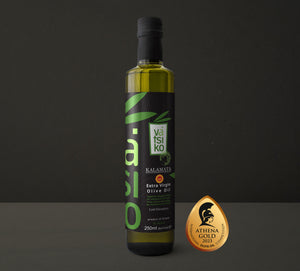Koroneiki Olive Oil
Regions of Messinia
 Kalamata is a region of Greece located in Messinia on the Peloponnese and is well-known for producing traditional snacking olives which are purple, almond-shaped, and plump. While Kalamata olives are ideal as table olives due to their large size and meaty texture, however, Stamatopoulos & Sons does not use them to produce oil since the Koroneiki olive is far superior. Kalamata olive trees bear leaves that are twice the size of other olive varieties.
Kalamata is a region of Greece located in Messinia on the Peloponnese and is well-known for producing traditional snacking olives which are purple, almond-shaped, and plump. While Kalamata olives are ideal as table olives due to their large size and meaty texture, however, Stamatopoulos & Sons does not use them to produce oil since the Koroneiki olive is far superior. Kalamata olive trees bear leaves that are twice the size of other olive varieties.
Stamatopoulos & Sons certified extra virgin olive oil is mono-varietal which means it is crafted from one type from olive. Koroni (where the koroneiki olive gets its name) is a town located in Messinia, close to the Stamatopoulos & Sons family estates, located in Mouzaki and Christianoupoli. The koroneiki olive is considered the “queen of olives” in Greece and is recognized world-wide as one of the preferred olives for oil production. The fruitful koroneiki tree has flourished in this microclimate for more than 3,000 years. It is grown and harvested solely for olive oil production.
While koroneiki olives produce velvety-smooth olive oil, these particular olives are quite bitter and are not intended for snacking. The leaves of the koroneiki tree have two tones: light and dark green, while the olives vary from light green to dark purple. Some koroneiki trees have both green and purple olives. Koroneiki trees are constantly changing and have their own unique appearance - similar to snowflakes - since the appearance of the leaves combined with the bi-colored olives and sometimes windy environment makes for quite a sight.
 Koroneiki is one of the most prized olive trees in both Australia and California, countries which do not have native olive trees. There are over 400 varieties of olives in existence today. Any variety olive tree could have been selected to be in their olive groves, however, they choose koroneiki because it is considered such a high-quality olive oil. Koroneiki olive oil production is sometimes considered more difficult to process than other olives due to the petite size of the koroneiki. Since it is such a small olive compared to other olives, it takes many more olives to create the same amount of olive oil. Moreover, koroneiki olives are tricky to harvest because they are smaller than other varieties. The quality of the koroneiki olive oil compared to some other olive oils is so superior, in fact, that if they were mixed together the koroneiki olive oil would improve the overall quality of the olive oil.
Koroneiki is one of the most prized olive trees in both Australia and California, countries which do not have native olive trees. There are over 400 varieties of olives in existence today. Any variety olive tree could have been selected to be in their olive groves, however, they choose koroneiki because it is considered such a high-quality olive oil. Koroneiki olive oil production is sometimes considered more difficult to process than other olives due to the petite size of the koroneiki. Since it is such a small olive compared to other olives, it takes many more olives to create the same amount of olive oil. Moreover, koroneiki olives are tricky to harvest because they are smaller than other varieties. The quality of the koroneiki olive oil compared to some other olive oils is so superior, in fact, that if they were mixed together the koroneiki olive oil would improve the overall quality of the olive oil.
Polyphenols
 The koroneiki olive produces olive oil with some of the highest polyphenol content possible. Polyphenols are natural antioxidants that have been credited with reducing the risk of heart disease and cancer, among many other diseases. Free radical damage is drastically reduced with the presence of polyphenols, as they protect the human body. Koroneiki olive oil has a prolonged shelf life compared to typical olive oils due to the incredibly elevated polyphenol content. Koroneiki olive oil also boasts low free fatty acids (FFA) which is a highly-prized characteristic.
The koroneiki olive produces olive oil with some of the highest polyphenol content possible. Polyphenols are natural antioxidants that have been credited with reducing the risk of heart disease and cancer, among many other diseases. Free radical damage is drastically reduced with the presence of polyphenols, as they protect the human body. Koroneiki olive oil has a prolonged shelf life compared to typical olive oils due to the incredibly elevated polyphenol content. Koroneiki olive oil also boasts low free fatty acids (FFA) which is a highly-prized characteristic.
According to Tom Mueller, author of Extra Virginity: The Sublime and Scandalous World of Olive Oil, Free fatty acidity or free acidity is “An important chemical parameter for determining the quality of an olive oil, which is part of the olive oil grading system of the IOC, the EU, the USDA, the Australian Olive Association, and many other bodies that oversee olive oil quality. FFA measures the percentage by weight of the free oleic acid (see Fatty acids, Oleic acid) contained in a sample of olive oil. In general terms, FFA indicates the breakdown of the basic fat structure of an oil, whether because of poor quality fruit (due to bruising, olive fly infestation, fungal attack) or, most commonly, by delays between the harvest and the crush. Although a low FFA is no guarantee of good quality, as a rule of thumb the higher the FFA, the more likely the oil is to be of poor quality. The level of 0.8 percent FFA set by the IOC and other regulatory bodies for the extra virgin grade is far too high to guarantee good oil: excellent extra virgin oil frequently has an FFA of 0.2 percent or lower, and anything over 0.5 percent is likely to be inferior.”


